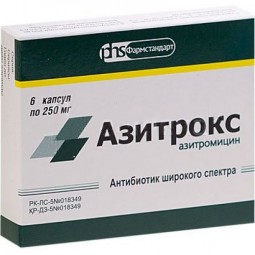Benzylpenicillin 1000000 Units, 1 Vial powder for solution for injection
- $2.00
Out Of Stock
Ingredients per bottle
Active ingredient: Benzylpenicillin sodium salt - 1000000 IU
Pharmacological properties
Pharmacokinetics
The maximum concentration in blood plasma when administered intramuscularly is reached after 20-30 minutes. The half-life of the drug is 30-60 minutes, with renal failure 4-10 hours or more. Communication with plasma proteins - 60%. Penetrates into organs, tissues and biological fluids, except for cerebrospinal fluid, eye tissues and prostate. With inflammation of the meningeal membranes, it penetrates the blood-brain barrier. Passes through the placenta and passes into breast milk. Excreted by the kidneys unchanged.
Pharmacodynamics
Bactericidal antibiotic from the group of biosynthetic ("natural") penicillins. Inhibits the synthesis of the cell wall of microorganisms. Active against gram-positive pathogens: staphylococci (non-forming penicillinase), streptococci, pneumococci, diphtheria corynebacteria, anaerobic spore-forming rods, anthrax rods, Actinomyces spp.; gram-negative microorganisms: cocci (Neisseria gonorrhoeae, Neisseria meningitidis), as well as against spirochetes.
Not active against most gram-negative bacteria (including Pseudomonas aeruginosa), Rickettsia spp., protozoa. Staphylococcus spp., which produce penicillinase, are resistant to the drug.
Indications for use
- croupous and focal pneumonia, pleural empyema, bronchitis
- sepsis, septic endocarditis (acute and subacute)
- peritonitis
- meningitis
- osteomyelitis
- pyelonephritis, pyelitis, cystitis, urethritis, gonorrhea, blennorrhea, syphilis, cervicitis
- cholangitis, cholecystitis
- wound infection
- erysipelas, impetigo, secondarily infected dermatoses
- diphtheria
- scarlet fever
- anthrax
- actinomycosis
- sinusitis, otitis media
- purulent conjunctivitis
Dosage and administration
Benzylpenicillin sodium salt is administered intramuscularly. With intramuscular injection, single doses for moderate disease (infections of the upper and lower respiratory tract, urinary and biliary tract, soft tissue infections, etc.) are 250,000 - 500,000 IU 4-6 times a day. In severe infections (sepsis, septic endocarditis, meningitis, etc.) - 10-20 million units per day; with gas gangrene - up to 40-60 million units.
Daily dose for children under the age of 1 year - 50,000 - 100,000 IU / kg, over 1 year - 50,000 IU / kg; if necessary - 200,000 - 300,000 U / kg, according to vital indications - an increase to 500,000 U / kg. The frequency of administration is 4-6 times a day.
A solution of the drug for intramuscular administration is prepared immediately before administration by adding 1-3 ml of water for injection, 0.9% sodium chloride solution or 0.5% procaine (novocaine) solution to the contents of the vial. When dissolving benzylpenicillin in a solution of procaine, turbidity of the solution may occur due to the formation of crystals of benzylpenicillin procaine, which is not an obstacle to intramuscular administration of the drug. The resulting solution is injected deep into the muscle. The duration of treatment, depending on the severity of the disease, is from 7 to 10 days.
Side effects
- violation of the pumping function of the myocardium, arrhythmias, cardiac arrest, chronic heart failure (since hypernatremia may occur with the introduction of large doses)
- nausea, vomiting, stomatitis, glossitis, abnormal liver function
- impaired renal function
- anemia, leukopenia, thrombocytopenia
- increased reflex excitability, meningeal symptoms, convulsions, coma
- allergic reactions: sometimes - hyperthermia, urticaria, skin rash, fever, chills, increased sweating, rash on the mucous membranes, arthralgia, eosinophilia, angioedema, interstitial nephritis, bronchospasm, rarely - anaphylactic shock
- local reactions: soreness and induration at the site of intramuscular injection
- dysbacteriosis, development of superinfection (with prolonged use)
Contraindications
- hypersensitivity to penicillin and other ß-lactam antibiotics
- endolumbar injection for epilepsy.
Drug Interactions
Antacids, glucosamine, laxatives, aminoglycosides slow down and reduce the absorption of benzylpenicillin sodium salt. Ascorbic acid, when used together, increases the absorption of benzylpenicillin sodium salt.
Bactericidal antibiotics (including cephalosporins, vancomycin, rifampicin, aminoglycosides) have a synergistic effect; bacteriostatic (including macrolides, chloramphenicol, lincosamides, tetracyclines) - antagonistic. Benzylpenicillin sodium salt increases the effectiveness of indirect anticoagulants (suppressing the intestinal microflora, reduces the prothrombin index); reduces the effectiveness of oral contraceptives, drugs, during the metabolism of which para-aminobenzoic acid is formed.
Diuretics, allopurinol, blockers of tubular secretion, phenylbutazone, non-steroidal anti-inflammatory drugs, reducing tubular secretion, increase the concentration of benzylpenicillin sodium salt.
Allopurinol increases the risk of developing allergic reactions (skin rash).
Special instructions
With caution: pregnancy, lactation, allergic diseases (bronchial asthma, pollinosis), renal failure.
Solutions of the drug are prepared immediately before administration. If after 2-3 days (maximum 5 days) after the start of the drug, there is no effect, you should switch to the use of other antibiotics or combination therapy. In connection with the possibility of developing fungal infections, it is advisable to prescribe B vitamins for long-term treatment with benzylpenicillin, and, if necessary, antifungal drugs. It should be borne in mind that the use of insufficient doses of the drug or too early termination of treatment often leads to the emergence of resistant strains of pathogens.
Pregnancy and lactation
The use of the drug during pregnancy is possible only if the intended benefit to the mother outweighs the potential risk to the fetus. If necessary, the appointment of the drug during lactation should stop breastfeeding.
Features of the influence of the drug on the ability to drive a vehicle or potentially dangerous mechanisms
During the administration of the drug, care should be taken when driving vehicles, mechanisms and when performing other potentially hazardous activities that require an increased concentration of attention and speed of psychomotor reactions.
Overdose
Symptoms: possible increased side effects and manifestations of toxic effects on the central nervous system (convulsions, headache, myalgia, arthralgia).
Treatment: symptomatic.
Storage conditions
Store in a dry place at a temperature between 15°C and 25°C
Keep out of the reach of children!
Shelf life - 3 years
Do not use after the expiration date.










